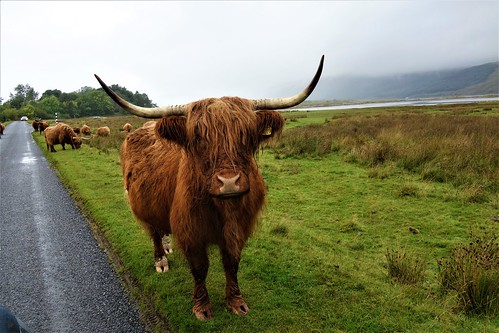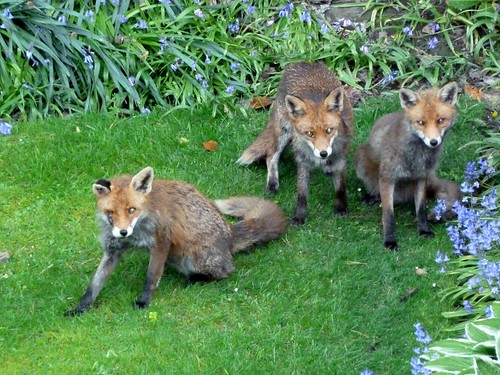Scotland's Wildlife
(Above image is a capture of a seal at Eyemouth Harbour in the east of Scotland.)
Whilst Scotland has a reasonably extensive array of wildlife with which a visitor can connect such would not be as varied or extensive as that which exists in, say, North America or Africa. Bears, wolves and beavers were exterminated in the past but beavers have recently been successfully reintroduced.
MAMMALS
Here is a listing of the principal mammals:
LAND BASED
Beavers: Now a protected species with growing populations. Officially reintroduced in Knapdale (near Lochgilphead) in S.W. Scotland. Viewing may be possible via specialist tour operators in that region. An 'unofficial' population numbering about 400 has become established in Tayside, central Scotland.
Red Squirrels: Once dominant but now endangered due to encroachment of the invasive grey squirrel imported from North America. Scottish population is down to about 160,000. The red is slightly smaller than the grey. Visitors may encounter chance sightings. A small colony may be visible near the entrance to Balmoral Castle in the Highlands.
Deer: Breeds include Roe, Red, Sika and Fallow. Chance encounters are possible in the remoter regions of the Highlands and Islands. There is an extensive population of Red Deer on the island of Jura (off the West Coast) which may be visible through binoculars and/or a long lens. There are some captive herds in fields used for meat (venison) production. Total deer population is estimated at 600,000.
Highland Cows: These are actually farm animals but small herds do free roam in parts of the Highlands and Islands and can be encountered ambling along back roads. Being very photogenic the animals have become a de facto symbol of Scotland but the total Scottish herd is low at less than 10,000 vs.. total cattle population of about 1.80M. Many visitor sites have a small number of the animals on show for benefit of tourists. There is a good chance of viewing the animals at:
- Pollok Park, Glasgow.
- Glamis Castle in Angus, eastern Scotland.
- Swanston Farm near Edinburgh.
- Glen Nevis, along a minor road running south from Fort William in the Highlands.
- At the Woollen Mill, Kilmahog near Callander in central Scotland.
- Isle of Mull, along back road to Fionnphort and Iona.
Wild Cat: An endangered species with tiny population of between 1000 and 4000. Similar in size to the domestic cat. There is a very low probability of visitors encountering these animals in the wild. There is a small group at the Highland Wildlife Park at Kingussie in the Highlands region.
Foxes: Relatively common with some populations having become urbanised.
Otters: Total population about 8,000. These animals are solitary hunters who obtain most of their food from rivers, lochs (lakes) and the sea. Preferred habitat is rocky shoreline with access to freshwater. To view these animals visitors will require patience and maybe local help. Aim for west coast of Highlands and the islands of Mull and Skye.
Pine Martens: Typically, about 20" long and of the same family as weasels and badgers. Restricted to woodland habitats in the Highlands. Feed on rodents, fruit and will sometimes scavenge from birdtables. Mostly chestnut brown in colour with a long, bushy tail. Pine Martens are elusive and unlikely to be encountered by tourists.
Wildlife Safari Trips
To connect with the outdoors and associated wildlife visitors could consider availing of off road safaris operated from Aberfeldy (central Scotland) and the National Trust Visitor Centre at Glencoe in the Highlands.
WATER BASED
Seals: The dominant species are harbour (or common) seals and grey seals with estimated populations of 24,000 and 126,000 respectively. To view seals there are boat trips within Oban Harbour (west coast)and from Dunvegan Castle of the Isle of Skye.
Dolphins: Trips/viewing are available at:
- The Scottish Dolphin Centre at Fochabers to the east of Inverness in the Highlands.
- Avoch on the Black Isle, north of Inverness.
- Chanonry Point on the Black Isle.
- Inverness Marina.
Whales: Trips are available from:
- Sealife Adventures, Seil, About 7 miles S.W. of Oban on the west coast.
- Seafari Adventures, Easdale Island, about 15 miles south of Oban.
- Various operators at Tobermory, Isle of Mull, off Scotland's west coast.
BIRD LIFE
Bird life and bird watching is covered in a separate section.
For ease of reference, principal sites for visitors are:
- Cairngorms National Park, eastern Highlands.
- Loch of the Lowes near Dunkeld, central Scotland.
- Lochwinnoch, Renfrewshire, West Central Lowlands.
- Isle of May, off the Fife Coast and accessed via boat from Anstruther.
.© Nigel P Cole/Catswhiskerstours Limited











Comments
Post a Comment